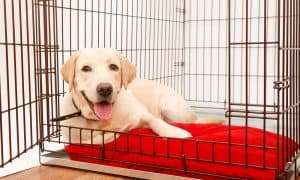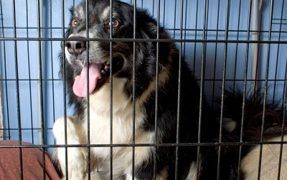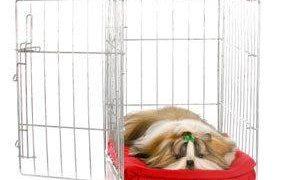“This post contains affiliate links, and I will be compensated if you make a purchase after clicking on my links.”
While there are many methods of training your dog, crate training is a very effective, very popular option. Some of the happiest, most well-behaved dogs I’ve ever met were crate trained, though it’s not for everyone. In fact, you may feel a bit guilty at first. Remember, dogs don’t think of their crate as a prison, as we would (as long as you don’t associate the crate with punishment) but rather, they think of it as a comfortable, safe space that’s all their own. However, crate training incorrectly can cause more harm than good – that’s why we’re providing our readers with these great tips from The Dog Guide for how to crate train your dog.
How To Crate Train Your Dog
If you ever notice your pup worming his way under a chair or couch, it’s because he feels secure in small spaces. A dog crate makes an excellent and safe small space or “den.” It doesn’t matter what type of crate you choose (though we personally prefer the wire type over the plastic sided due to the increased airflow), as long as you get the correct size for your dog. He should have only enough room to stand up, turn around and lie down. If you purchase a crate that is too large, make sure it comes with a divider so you can section it off until he is larger. If the crate is too large it only encourages accidents, as your dog is able to get away from his messes.
The single most important rule of crate training is that the crate is NEVER EVER to be used as a place of punishment. You are not to put your dog in his crate when he is being bad, when he needs a time out or anything of that nature. You want your dog to associate only pleasant sensations with the crate, and using it for any other purposes would ruin this. However, crate training can be used for any times when you are unable to watch your dog, not just when you are leaving the house. In fact, working with crate training while you are in the house is a good way to “troubleshoot” in the beginning stages.
When you set up the crate for your dog, you can place some safe bedding (nothing shred-able or stringy) inside the crate. You should also leave the door open and whenever he wanders in, throw him a treat and say “good crate” or whatever term you want to use as the command. Feeding him in the crate is another way to get him used to entering and exiting the crate regularly as well as develop a positive association with it.
While choosing what to put in the crate, consider your dog’s habits: does he like to destroy his toys? If so, leave out anything that can be ripped apart- stuffed animals, etc. Some dogs will be happy chewing on rawhide, while others may be overly enthusiastic and choke themselves on a piece of rawhide. Strong rubber or hard plastic toys that are too large to be swallowed are generally safe, and we always recommend Kongs, or anything similar that can be stuffed with treats/peanut butter. In warmer weather, leaving water with your dog is a good idea too (as long as he is old enough to be in the crate without needing to pee for as long as you leave him there). Some people use bowls; we use a large water bottle- the same kind used for small animal cages- that attaches to the side of the crate. Our puppy likes to play with water bowls and knock them over, so this way he has access to water without making a mess of his crate.
The first time you leave your pup alone in the crate, prepare a special toy for the occasion. This toy will only be given to him when he is in his crate. This way he will know that something special comes when he is left. We use a Kong toy stuffed with peanut butter and various treats, and one of our pup’s favorite stuffies. Our dogs spend hours working to get all of the food out of the toy. They keep busy and we feel better knowing they are occupied while they are alone. When the dog comes out of the crate the toy gets put away until next time.
When you return from your outing, do not make a big deal out of letting your dog out of the crate. In fact, the best way to handle this process is to ignore him and take him right outside. Once he has done his business then you can greet him. You don’t want him getting the idea that coming out of the crate is a good thing, because then he will be unsettled and anxious while in his crate.
Troubleshooting: If your dog is whining while in the crate, stand where he can’t see you. Ignore it without response for 5 minutes. Then, if that fails, take an empty soda can filled with pennies and give it one shake. That usually startles the dog and quiets him down. At that point, wait until he is quiet for at least 30 seconds and then let him out of the crate. Never let a whining dog out of a crate, as it only encourages the behavior.
As a general guideline, use your pup’s age in months plus one as the number of hours he can stay in the crate comfortably. However, we are not comfortable and do not recommend leaving a dog in a crate for periods longer than 6 hours without a break.
Continue reading here. Are you the proud parent of a crate trained dog? Do you have any other tips for our readers on how to crate train a dog? Share them with us below!


















